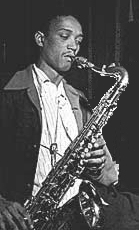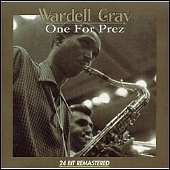The death of Wardell Gray has not been completely cleared up but it is not for us to attempt to solve any mysteries here. His life, rather than his death, is what concerns us.
Born in Oklahoma City in 1921, Wardell moved to Detroit where he studied music at Cass Tech High. After playing with the local bands of Jimmy Rachel and Benny Carew, he did his first name band work with Earl Hines, doubling on tenor and clarinet from 1943 to 1945. Then he was with Billy Eckstine's big band for a short spell before joining Benny Carter in 1946. Carter has always had great admiration for Wardell's playing and Benny is not lavish with praise for many of the modern jazzmen. With Carter, Wardell went out to the West coast and decided to remain for a while. 1947 found him participating in many of the jazz concerts so popular there at that time, often times with Dexter Gordon and Sonny Criss. Through these appearances and recordings, he began to be more widely known.
The Lester Young style he had shown with Hines was still in evidence, a pure-toned driving style which underwent change in the following year. When Wardell came to New York in 1948 to become part of the Benny Goodman Sextet you could hear the shift to Charlie Parker's influence. Later that year he appeared at the Royal Roost with Tadd Dameron's group and Count Basie's band. In 1949 it was back to Goodman, this time the big band. By the time he had finished an engagement at the Orchid Club (the old Onyx) on 52nd Street with Sonny Stitt in early 1950, Wardell's style had changed completely over to the harder sound and crisper attack. "Twisted" [mp3]
from 1949.
He returned to Detroit and spent several months there with his own quartet. When Count Basie formed a small band, Wardell answered his call. Until the end of 1951 when he settled in California, he played intermittently with Count in both small and large groups. We never saw him in the East after that. Outside of a few recording sessions he wasn't heard from. The West Coast may have been booming, but not for all.
Whatever he played swung, for primarily Wardell was a swinger. Moving along at up-tempo, he would still exhort the rhythm section to "bear down."
According to Art Farmer, my source for a lot of the information in these notes, Wardell was not one to put other musicians down. He did speak frankly about whom he thought he played better than and vice versa. On tenor Sonny Stitt and Frank Foster drew his praise.
This LP is a monument to the music of Wardell Gray. It is not one of marble or granite, but a phonograph record which lives and helps relive.
--IRA GITLER, from the liner notes,
Wardell Gray Memorial, Prestige.
A selected discography of Wardell Gray albums.





